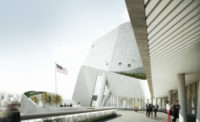Twin Peaks: Two Renowned New York Sports Facilities to Get New Roofs

5,000 Tons of Steel for an Umbrella
In Queens, Arthur Ashe Stadium, the 23,000-seat centerpiece of the National Tennis Center, has been plagued by rain delays during important matches. The solution, a retractable roof, has been on the table practically since the venue was completed in 1997. But because interior supports, which would block views of the court, were never a viable option, columns had to be separated by the width of the stadium — more than 500 feet. Over the years, the United States Tennis Association (USTA) commissioned three separate studies, each of which estimated that such a structure would cost at least $200 million — a lot to cover a facility used only two weeks a year, during the U.S. Open.
Rossetti Architects, the Detroit-based firm that designed the stadium, was determined to solve the problem even conducting studies at its own expense. Working with the engineering firm WSP, Rossetti came up with a plan in which groups of three columns would splay from shared bases, so that 24 columns would require just eight bases. The columns would climb 125 feet, where they would carry four huge trusses. The trusses, in turn, would support roof panels of Teflon-coated fiberglass, with the two operable panels totaling 62,000 square feet. It will be possible to open or close the panels in 5 to 7 minutes, says John Disbrow, Rossetti’s lead architect on the project.
The addition of a roof — even a retractable one — means the stadium will have to be cooled, though Disbrow said the air will be “tempered” rather than fully air-conditioned. “On a 100-degree day it won’t be 75 inside,” he says. Another concern was avoiding condensation. “We have players on a court who are playing at the absolute highest level, and you don’t want drips coming down,” he says. There were also seismic concerns — in the event of an earthquake, the stadium and roof supports needed to be able to move independently. Construction of the 5,000-ton steel structure, which began in 2013, is expected to cost $100 million and be completed in time for the 2016 U.S. Open—barring rain delays.
1,800 Tons of Steel for a “Zen Garden”
Meanwhile, 10 miles southwest, a three-year-old arena is getting a green roof. Since Barclays Center, the rust-colored home of the Brooklyn Nets, was completed in 2012, neighbors have complained about noise exiting through its roof during concerts. That posed a problem for the developers, Forest City Ratner, and its Chinese partner, Greenland Group USA, which plan to build 14 residential towers, containing some 6,400 units, around the arena. For that reason, “Greenland Group USA is paying for the roof (though they are not an owner of the arena itself),” Barclays spokesman Joe DePlasco explained in an e-mail.
In addition to solving the noise problem, the green roof should give residents something more attractive to look at than the existing painted surface, sporting a giant Barclays logo. “They’re going to be looking down on this mosaic of green, instead of a gray reflective roof,” says Chris Sharples, the SHoP Architects partner in charge of the project, who also calls it “a giant zen garden.” (SHoP designed the roof, with AECOM as architect of record.) DePlasco said that trucks will begin arriving with shrink-wrapped pallets of sedum in early May. The green roof is expected to be completed this fall.
First steelworkers had to give the arena a second roof, approximately 10 feet above the existing one. “I wish we could have just gone up there with some dirt,” says Robert Sanna, the head of construction for Forest City Ratner. But the existing trusses had to be augmented with new trusses, to support the weight of the soil and the sedum. The job required 1,311 tons of structural steel and 515 tons of steel joist and deck, he says.
For months three massive cranes have been lifting all that steel from the street to the arena’s roof. But not everything has gone as planned. In February a worker was killed moving beams from a truck to a hoist; that led the city to impose a partial freeze on construction, delaying work, Sanna said, by three or four days.
Meanwhile, the roof’s environmental cred has been called into question. A 2013 article in Scientific American explained that, while sedum is chosen for its durability, “A roof planted with sedum, however, is no greener, from the standpoint of sustainability, than is ordinary tar or asphalt.” Not only that, but in the case of Barclays, Treehugger blogger Lloyd Alter wrote, “The carbon footprint and embodied energy of so much steel far outweighs the environmental benefits of any green roof, let alone this one. The whole thing, from start to finish is a multimillion dollar environmental negative.”
But Sanna disagrees. “130,000 square feet is a lot of green,” he says, adding, “Some of the rain that falls will be absorbed into the plant material; that reduces the amount of water flowing into the sewers.” The green roof will also reflect less heat into the buildings around the arena, Sanna says. And it will have a “marginal effect” on heat absorption into the arena, cutting air conditioning loads. Sharples makes another point about the roof’s overall environmental impact: “If we can find a way to get more people to live closer together by creating open spaces that make our cities more attractive, we’ll reduce our carbon footprint.”




